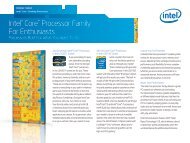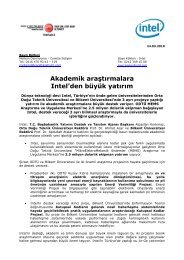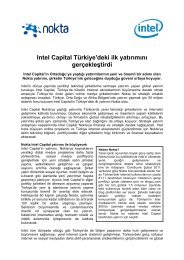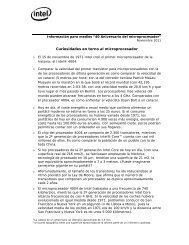Intel at VLSI Fact Sheet.pdf
Intel at VLSI Fact Sheet.pdf
Intel at VLSI Fact Sheet.pdf
You also want an ePaper? Increase the reach of your titles
YUMPU automatically turns print PDFs into web optimized ePapers that Google loves.
<strong>Fact</strong> <strong>Sheet</strong><br />
<strong>Intel</strong> Talks about Future Technologies for Processors,<br />
Reveals New Details about 22nm 3-D Tri-G<strong>at</strong>e Transistors<br />
New Innov<strong>at</strong>ions Presented <strong>at</strong> 2012 IEEE Symposia<br />
on <strong>VLSI</strong> Technology and Circuits, June 12-15<br />
June 12, 2012 – <strong>Intel</strong> Corpor<strong>at</strong>ion is delivering myriad present<strong>at</strong>ions, panel discussions and<br />
demonstr<strong>at</strong>ions <strong>at</strong> this year’s <strong>VLSI</strong> Symposia. A highlight paper discloses new details about<br />
<strong>Intel</strong>’s 22nm process – the industry’s first fully depleted 3-D tri-G<strong>at</strong>e technology with superior<br />
low voltage and low power capabilities. Other <strong>Intel</strong> papers describe innov<strong>at</strong>ions in reducing<br />
power consumption for graphics processing, advances in transistors made with compound<br />
semiconductors, a viable option for future ultra-low power transistors, fundamental leaps in<br />
energy-efficient computing and integr<strong>at</strong>ed digital radio and SoC technology.<br />
Below are highlights covering <strong>Intel</strong>’s scheduled presence <strong>at</strong> the event.<br />
Details on <strong>Intel</strong>’s 22nm Process with Tri-G<strong>at</strong>e Transistors<br />
Chris Auth, 22nm front-end integr<strong>at</strong>ion manager, describes <strong>Intel</strong>’s 22nm logic technology, the<br />
first in the industry fe<strong>at</strong>uring fully depleted 3-D tri-g<strong>at</strong>e transistors. This paper was selected by<br />
the <strong>VLSI</strong> Symposia as a “highlight” paper. The fully depleted transistors provide significant<br />
improvements in transistor switching characteristics, specifically record low sub-threshold slope<br />
and DIBL. These transistors also incorpor<strong>at</strong>e a 3 rd gener<strong>at</strong>ion high-k + metal g<strong>at</strong>e technology and<br />
a fifth gener<strong>at</strong>ion of channel strain techniques, resulting in the highest drive currents yet reported<br />
for NMOS and PMOS. The technology is optimized for high performance and low power,<br />
offering triple threshold voltage transistors with different combin<strong>at</strong>ions of performance and<br />
leakage. Self-aligned contacts are implemented to elimin<strong>at</strong>e restrictive contact to g<strong>at</strong>e<br />
registr<strong>at</strong>ion requirements, facilit<strong>at</strong>ing manufacturability. Interconnects fe<strong>at</strong>ure nine metal layers<br />
with ultra-low-k or low-k dielectrics throughout the interconnect stack. High-density MIM<br />
(metal-insul<strong>at</strong>or-metal) capacitors using a hafnium-based high-k dielectric are provided for<br />
signal and decoupling applic<strong>at</strong>ions. The technology is in high volume manufacturing in multiple<br />
fabs.<br />
Paper and contributors details:<br />
15.2: A 22nm High Performance and Low-Power CMOS Technology Fe<strong>at</strong>uring Fully Depleted<br />
Tri-G<strong>at</strong>e Transistors, Self-Aligned Contacts and High Density MIM Capacitor, C. Auth, C. Allen,<br />
A. Bl<strong>at</strong>tner, D. Bergstrom, M. Brazier, M. Bost, M. Buehler, V. Chikarmane, T. Ghani, T.<br />
Glassman, R. Grover, W. Han, D. Hanken, M. H<strong>at</strong>tendorf, P. Hentges, R. Heussner, J. Hicks, D.<br />
Ingerly, P. Jain, S. Jaloviar, R. James, D. Jones, J. Jopling, S. Joshi, C. Kenyun, H. Liu, R.<br />
McFadden, B. McIntyre, J. Neirynck, C. Parker, L. Pipes, I. Post, S. Pradhan, M. Prince, S.<br />
Ramey, T. Reynolds, J. Roester, J. Sanford, J. Seiple, P. Smith, C. Thomas, D. Towner, T.<br />
Troeger, G. Weber, P. Yashar, K. Zawadzki, K. Mistry, <strong>Intel</strong>
Pushing Performance and Energy Efficiency Beyond the Traditional Limits<br />
This research from <strong>Intel</strong> Labs, selected by the <strong>VLSI</strong> Symposia as a “highlight” paper,<br />
demonstr<strong>at</strong>es a test chip in 22nm tri-g<strong>at</strong>e process th<strong>at</strong> enables elimin<strong>at</strong>ion of voltage droop<br />
margins, safeguards th<strong>at</strong> today protect against temporary voltage reductions th<strong>at</strong> occur<br />
occasionally during processor oper<strong>at</strong>ion. Voltage droop margins leave performance and energyefficiency<br />
on the table and removing them can significantly improve processor performance and<br />
energy efficiency. This technique focuses on dynamically adapting the chip’s clocking to these<br />
rare voltage reductions. While previous techniques have focused on detecting and correcting<br />
occasional errors, this technique delays the occurrence of timing errors, autom<strong>at</strong>ically shuts<br />
down clocking in the affected region before an error actually occurs, and then restarts when the<br />
transient droop event goes away. Measurements demonstr<strong>at</strong>e simultaneous throughput gains and<br />
energy reductions ranging from 14 percent and 3 percent, respectively, <strong>at</strong> 1.0V to 31 percent and<br />
15 percent <strong>at</strong> 0.6V for a 10 percent voltage droop.<br />
12.1: A 22nm Dynamically Adaptive Clock Distribution for Voltage Droop Tolerance, K.<br />
Bowman, C. Tokunaga, T. Karnik, V. De, J. Tschanz, <strong>Intel</strong><br />
Reducing Power for Processing Graphical Applic<strong>at</strong>ions<br />
This research test chip from <strong>Intel</strong> Labs is designed to make flo<strong>at</strong>ing point calcul<strong>at</strong>ions more<br />
energy efficient, particularly for visual comput<strong>at</strong>ions in future processor graphics engines.<br />
Today, most graphical applic<strong>at</strong>ions, such as games, use 32 bits of inform<strong>at</strong>ion to store and<br />
calcul<strong>at</strong>e numbers when less would suffice. This test chip fe<strong>at</strong>ures a first-of-its-kind variableprecision<br />
scheme th<strong>at</strong> enables 24-, 12- and even 6-bit precisions, selecting the minimum<br />
precision needed to optimize efficiency. This scheme has the potential to cut power in half for<br />
some graphics applic<strong>at</strong>ions. This research focuses on innov<strong>at</strong>ions in the register files used to<br />
store the variable-precision numbers feeding the flo<strong>at</strong>ing-point unit. The register file also utilizes<br />
near threshold voltage (NTV) circuits to enable ultra-low power processing. Measurements<br />
demonstr<strong>at</strong>e read/write oper<strong>at</strong>ions over a wide dynamic voltage range spanning 1.2V down to<br />
350mV and a peak energy-efficiency of 751 billion oper<strong>at</strong>ions per w<strong>at</strong>t (<strong>at</strong> 400mV) for low-<br />
precision calcul<strong>at</strong>ions – an improvement of more than 20x over full-precision calcul<strong>at</strong>ions <strong>at</strong><br />
nominal voltage. In addition, it enables 19 perecent area reduction for these register files,<br />
enabling smaller and more cost-effective chips.<br />
14.5: A 2.8GHz 128-entry x 152b 3-Read/2-Write Multi-Precision Flo<strong>at</strong>ing-Point Register File<br />
and Shuffler in 32nm CMOS, S. Hsu, A. Agarwal, M. Anders, H. Kaul, S. M<strong>at</strong>hew, F. Sheikh, R.<br />
Krishnamurthy, S. Borkar, <strong>Intel</strong><br />
<strong>Intel</strong>’s Semiconductor Research Pipeline<br />
Continued advances in electronics require not only better CMOS devices but improvements in<br />
our ability to precisely fabric<strong>at</strong>e novel m<strong>at</strong>erials and structures. This talk by Mike Mayberry,<br />
<strong>Intel</strong> vice president and director of <strong>Intel</strong>’s Components Research, highlights some of the key<br />
directions for the next few gener<strong>at</strong>ions and then discusses opportunities for beyond CMOS<br />
devices in the next decade.<br />
1.1: Peering through the Technology Scaling Fog (Invited), M. Mayberry, director of<br />
Components Research, <strong>Intel</strong> Corp.<br />
Progress in Transistors Using Compound Semiconductors, for Ultra-Low Power Chips
Gilbert Dewey, senior device engineer, summarizes the performance of compound<br />
semiconductor (III-V) field effect transistors (FETs) including thin body planar MOSFETs, 3-D<br />
tri-g<strong>at</strong>e MOSFETs, and Tunneling FETs (TFETs) for low-power applic<strong>at</strong>ions. Due to inherently<br />
higher carrier mobility, III-V MOSFETs are shown to have a significant low-power performance<br />
advantage over st<strong>at</strong>e-of-the-art planar Strained Si MOSFETs. The sub-threshold slope (SS) and<br />
DIBL in the III-V MOSFETs improve from thick body planar to thin body planar with further<br />
improvement shown in 3-D tri-g<strong>at</strong>e III-V MOSFETS. Beyond the MOSFET structures, subthreshold<br />
slope steeper than the best possible MOSFET (
advanced circuit design technologies. Industry leadership results in SRAM performance, density,<br />
and low-voltage oper<strong>at</strong>ion will be presented.<br />
10.1: SRAMs Design in Nano-Scale CMOS Technologies (Invited), K. Zhang, <strong>Intel</strong><br />
A Technology for Implementing Read-Only Memories in <strong>Intel</strong>’s 32nm Process<br />
Anti-fuse technology for implementing on-chip one-time-programmable read-only memory<br />
(OTP-ROM) holds the promise of achieving high-density ROM arrays with large-scale parallel<br />
write ability. Example applic<strong>at</strong>ions include on-chip encryption keys, microcode storage and dielevel<br />
post-Si tuning. While earlier work has focused on earlier polysilicon-g<strong>at</strong>e SiO2/SiONbased<br />
technology gener<strong>at</strong>ions, in this paper, Sarvesh Kulkarni, senior design engineer, <strong>Intel</strong><br />
presents the first demonstr<strong>at</strong>ion of anti-fuse memory in high-k + metal g<strong>at</strong>e CMOS. The paper<br />
presents a 1.01µm2 one-transistor one-capacitor (1T1C) bit cell th<strong>at</strong> is the smallest in liter<strong>at</strong>ure.<br />
The technology incurs zero cost overheads over the underlying SoC process and demonstr<strong>at</strong>es a<br />
high-density array architecture th<strong>at</strong> meets reliability requirements and is programmable <strong>at</strong> 4.5V.<br />
9.2: A 32nm High-K and Metal-G<strong>at</strong>e Anti-Fuse Array Fe<strong>at</strong>uring a 1.01μm2 1T1C Bit Cell, S.<br />
Kulkarni, S. Pae, Z. Chen, W. Hafez, B. Pedersen, A. Rahman, T. Tong, U. Bh<strong>at</strong>tacharya, C.-H.<br />
Jan, K. Zhang, <strong>Intel</strong><br />
Fine-Grained Power Management for Processors and SOCs<br />
In chips today, different regions of a chip often share a common voltage source, which may not<br />
be the most efficient choice in terms of performance and power consumption for different<br />
circuits. Energy efficiency can be improved by enabling multiple independent voltage domains<br />
and fine-grain power management, so th<strong>at</strong> each region on a processor or SOC can run <strong>at</strong> an<br />
optimum voltage. This research from <strong>Intel</strong> Labs describes a technique to efficiently gener<strong>at</strong>e<br />
many different voltages on the chip from a single voltage source coming into the chip from a<br />
pl<strong>at</strong>form voltage regul<strong>at</strong>or on the board. This fully digital linear voltage regul<strong>at</strong>or can be<br />
sprinkled across the chip to allow fine-tuning and control of voltage levels independently per<br />
region. It is capable of oper<strong>at</strong>ing across a wide range of input voltages and currents, and provides<br />
a conversion power efficiency th<strong>at</strong> is as high as 97 percent of the ideal efficiency limit. Being<br />
fully digital, the regul<strong>at</strong>or design can be migr<strong>at</strong>ed efficiently across process technology nodes,<br />
and is flexible as well as area-efficient. This technique will allow fine-tuning of a wide variety of<br />
circuits in future processors and SoC’s to provide tolerance of process and environmental<br />
vari<strong>at</strong>ions, and achieve better performance and energy efficiency.<br />
17.5: Fully-Digital Phase-Locked Low Dropout Regul<strong>at</strong>or in 32nm CMOS, A. Raychowdhury, D.<br />
Somasekhar, J. Tschanz, V. De, <strong>Intel</strong><br />
Helping Chips Optimize their D<strong>at</strong>a I/O Links<br />
Timing accuracy of clocking circuits is critical to achieve performance targets of high-speed I/O<br />
links. The calibr<strong>at</strong>ion and correction of clocking and timing issues caused by process, voltage<br />
and temper<strong>at</strong>ure vari<strong>at</strong>ions in I/O links of chips in high-volume manufacturing pose major<br />
challenges for external testing equipment and test time. This research from <strong>Intel</strong> Labs adds a key<br />
capability to help chips optimize their own I/O links for maximum d<strong>at</strong>a r<strong>at</strong>e and energy<br />
efficiency by monitoring test-time or run-time timing vari<strong>at</strong>ions with a high degree of accuracy.<br />
This capability is enabled by an on-die, all-digital delay measurement circuit th<strong>at</strong> precisely<br />
characterizes timing with an accuracy of 250fs (250 quadrillionths of a second). The all-digital
approach promises easier migr<strong>at</strong>ion, better area efficiency and better scalability across future<br />
process technology nodes.<br />
12.3: An On-Die All-Digital Delay Measurement Circuit with 250fs Accuracy, M. Mansuri, B.<br />
Casper, F. O'Mahony, <strong>Intel</strong><br />
Scaling Digital Radio<br />
Process constraints are unfriendly to radio frequency performance, and make it a challenge to<br />
integr<strong>at</strong>e RF into advanced digital CMOS manufacturing processes. This paper presents a WiFi<br />
transceiver in 32nm CMOS process th<strong>at</strong> could potentially scale down in size and power<br />
consumption as it would transition to more advanced manufacturing process technologies in the<br />
future.<br />
10.2: A 2.4GHz WLAN Transceiver with Fully-integr<strong>at</strong>ed Highly-linear 1.8V 28.4dBm PA,<br />
34dBm T/R Switch, 240MS/s DAC, 320MS/s ADC, and DPLL in 32nm SoC CMOS, Y. Tan, J.<br />
Duster, C.-t. Fu, E. Alpman, A. Balankutty, C.C. Lee, A. Ravi, S. Pellerano, K. Chandrashekar,<br />
H. S. Kim, B. Carlton, S. Suzuki, M. Shafi, Y. Palaskas, H. Lakdawala, <strong>Intel</strong> Corpor<strong>at</strong>ion<br />
-- 30 --<br />
<strong>Intel</strong>, the <strong>Intel</strong> logo and Atom are trademarks of <strong>Intel</strong> Corpor<strong>at</strong>ion in the United St<strong>at</strong>es and other countries.<br />
* Other names and brands may be claimed as the property of others.<br />
CONTACTS: Connie Brown Radoslaw Walczyk<br />
503-791-2367 408-765-0012<br />
connie.m.brown@intel.com radoslaw.walczyk@intel.com













